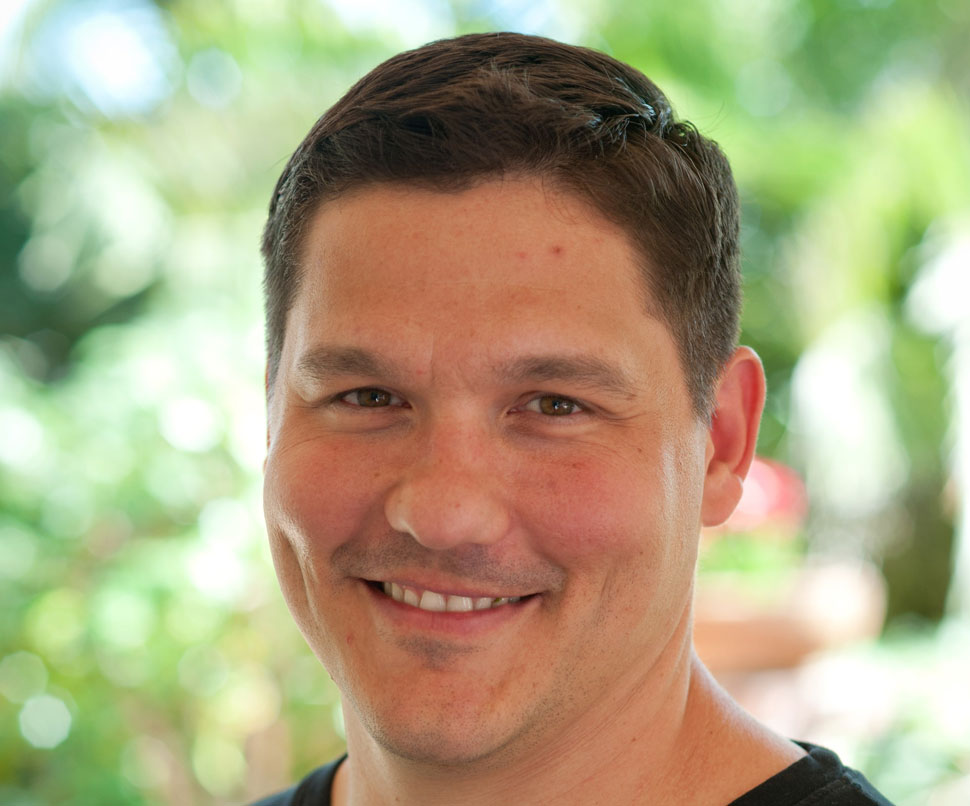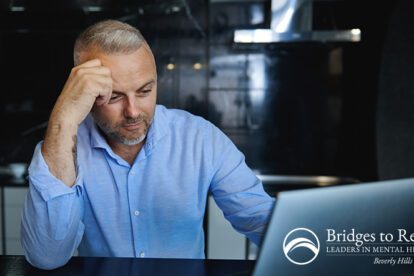An Exercise in Personal Transformation: An Interview with Fitness Instructor Mike Piacentino

The benefits of exercise for mental health disorders have been the subject of substantial research and media coverage in recent years; physical movement has been found to do everything from lifting depression to producing neuroprotective proteins for people with schizophrenia, offering a non-pharmacological adjunct to traditional treatments. At this point, few of us have to be convinced that we should exercise. Putting this knowledge into practice, however, can be a more complicated matter, especially in the midst of psychiatric crisis. That’s where Mike comes in.
Mike Piacentino is a Certified Fitness Instructor at Bridges to Recovery, specializing in fitness lifestyle management. Twice a week he teaches group classes using an innovative mix of exercises that challenge the body and enhance psychological wellness in a personal, supportive environment. In this interview, he shares his insights into the role of physical fitness within the context of mental health treatment, and the transformative potential of exercise.
Exercise Is a Great Balancer
At the beginning of your time with Mike, you’ll start with a discussion about your health history and what you hope exercise will help you accomplish. But one question he doesn’t ask: what is your diagnosis? That’s because the specific source of your distress is largely irrelevant in this situation; exercise will be what you need it to be.
“Exercise is a great balancer,” Mike tells me. “If you are anxious, it calms you down. If you are low-energy, it energizes you.” As such, exercise is in many ways inherently personalized, adapting to your unique needs to create physiological balance and supporting you in the way that makes sense for you.
But exercise also does more than that; on a biochemical level, it allows for the processing of unresolved stress and trauma that can interfere with healthy psychological functioning.
Exercise does a lot of balancing of the biochemistry in the body. The stress hormones that we experience from non-physical, emotional stress are the same stress hormones we experience in fight or flight reactions. When you have mental stress or anxiety, your body is preparing itself for physical activity, and exercise is the only way to use that energy, because your body sees exercise as that fight or flight response.
Regular exercise allows your body to get better at moving those stress hormones around and using them up, lowering your baseline stress levels and continuously giving you a way of coping with stress on a biological level. This accounts for the mental benefits so many people report when they establish a regular workout routine, something Mike can help clients set up.
Begin Your Recovery Journey.
877-727-4343Redefining Goals and Finding Motivation
Of course, that doesn’t mean that all exercise is created equal; which type of exercise you engage in will depend on your specific goals—and this where Mike’s work really begins. “Most people come into treatment with very general goals,” he says. “They want to lose weight, they want to be more fit.” What Mike does is help you refine your goals and, often, redefine them altogether. “I focus on action-oriented goals rather than aesthetic goals,” Mike explains.
The aesthetic-oriented goals tend to be very fleeting, because there’s a lot involved in changing the way you look: it requires a lot of time, and it requires precise balancing of food intake and exercise. Any slight change, such as water retention, can throw you off track and discourage you, and then you may not continue doing the actions that, in a year’s time, would have you in amazing shape. Aesthetic goals can be derailed very quickly and destroy your motivation.
So he changes the conversation. What begins as a goal of losing 10 pounds becomes a goal of doing five sets of presses, or doing 30 minutes of cardio three times a week. The key, Mike explains, is consistency of movement. “If your goal is to lose X number of pounds, you can become discouraged in you don’t see results in a week,” he explains. Having an immediate, tangible goal that you can achieve day-to-day, however, makes you stick with it, and eventually translates into those more general goals.
Mike also believes that the structure of physical fitness at Bridges to Recovery is an essential piece of the motivational puzzle; by working out as a group, you are able to observe and support your peers challenging themselves and creating change. “When people see other people doing it, they say, ‘If they can do that, I can do more than I’m doing,’ and that begins that shift in energy toward doing more.” Seeing people like you accessing exercise and getting results makes it more psychologically inviting, and spurs you toward your own transformation. The result is increased confidence, a sense of possibility, a feeling of accomplishment, and the joy of camaraderie.
A Biological Approach
One of the reasons Mike is able to help clients redefine their vision of what exercise can do for them is his biological approach to physical fitness; the body, he says, is one of the most researched subjects in history, and we have a clear picture of how and why it functions. We know how to change it, how to heal it, and how to move it in positive ways. But many people come into treatment with incorrect understandings of how the body and exercise work: more is better, pushing yourself to the max will help you achieve your goals, the number on the scale is what counts, and so forth. This misinformation can be demoralizing and even damaging.
“Women, especially, are taught that weight is what matters,” Mike says. “If they’re exercising and don’t see their weight changing—because fat is being replaced by muscle—they give up.” But what most people really want isn’t losing weight, but losing size, and that has very different implications for both exercise and personal motivation.
A brick and a pile of pillows may both weigh five pounds, but the pillows are going to take up much more space. Fat is like the pillows; it’s soft, less dense tissue, so it takes up way more volume for its weight than muscle. That’s why the scale should not be used as a measure of success. You can get smaller and leaner and still stay the same weight, or even gain weight depending on how you’re training and how much muscle you’re putting on.
By achieving your daily goals and focusing on inches rather than pounds, you can transform your physical self without the self-flagellation and loss of drive that often come with general weight loss goals.
I had a client many years ago. She was a low-activity, small-framed person with a higher level of body fat, but as we started training over the course of several months, she became leaner and stronger. She had abs, she had defined arms, and she was really happy. But when a doctor’s visit revealed that she had gained five pounds, she called me upset and asked me, ‘What are we doing?’ And I said, ‘Yeah, you gained weight, but you have abs, you feel great, and you are constantly inundated with friends and family telling you how amazing you look—so why do you care about those five pounds?’ The number isn’t what matters.
This is particularly pertinent for clients at Bridges, who often come in with depleted health due to poor eating habits and low activity as the result of their psychological state interfering with self-care. In these situations, weight gain is common once proper nutrition and exercise programs are implemented, yet that weight gain reflects improved physical health. By breaking down number-focused goals and replacing them with an understanding of how exercise impacts the body, Mike’s clients are able to move toward better conditioning and, just as importantly, stick with it over the long-term.
Call for a Free Confidential Assessment.
877-727-4343Less May Be More
For many, reframing exercise within a biological rather than an aesthetic context and cutting through destructive myths is eye-opening, especially for those with body image issues. For one client in particular, it was revolutionary. After previously working out with a trainer who pushed her to the brink at every session, she remained unsatisfied with her body, and had developed a negative relationship with exercise as a whole; working out was not enjoyable, and it was making her body bigger, not smaller as she hoped. By guiding her toward the movements that would allow her reach her goal(that of losing size) and, more importantly, helping her understand why it works, Mike was able to open up the path to a healthier relationship with her body and with physical fitness.
“As her body started to change from this lighter, more focused exercise program, she started to see that the gym doesn’t have to be this brutal, almost self-abusive endeavor,” Mike tells me. “As I trainer I have to ask myself, ‘Am I feeding into a negative mindset that already exists there?’” His goal, ultimately, is to help people see exercise as a way to care for, not punish, themselves, and break out of damaging patterns of thought and behavior, not become an extension of those damaging patterns.
The idea of honoring your body and making exercise more inviting is a thread that runs throughout Mike’s work; he teaches you how to move and listen to your body in a way that lets you achieve success and enjoy what you are doing. He emphasizes the value of letting your body rest and listening to what it is telling you. Challenging your body must be accomplished in healthy and safe ways, he says, not just for your own well-being, but to get the best results.
Exercise as Self-Care
Demystifying physical fitness is critical to creating a positive association with exercise and with your somatic self. By gaining greater awareness of how your body moves and holds itself, you learn how it reflects your emotional state and use that knowledge to spur change in your everyday life. After all, Mike notes, the time spent exercising is only a small portion of your day, but those 30 minutes or that hour can be translated into fortifying yourself emotionally and physically throughout the entire day, whether it’s improving your posture, giving you more endurance, improving self-esteem, or learning how to identify and release stress to promote inner tranquility. “The more we can open and expand the body, we can affect the regular position of the body, how the person holds it in their daily lives, and their awareness of their body,” Mike says. “Once that awareness kicks in, you feel more capable and stronger.”
That is ultimately the value of integrating physical fitness into a mental health treatment program: rejuvenating your mind, body, and spirit and learning how to nurture yourself in loving ways. “By coming to treatment, you are doing one of the hardest things you will ever do. You are doing more than most people will ever have to do,” Mike says. His classes offer a place of solace during a time of emotional turbulence, a place where you can solely focus on your own wellness, feel empowered, and know you are making meaningful, concrete change that will buoy you emotionally and physically throughout treatment and beyond.
Exercise is self-care. It is one of the few activities in which you are improving your wellness right in that moment. It is literally making you feel better right now because it’s altering the biochemistry in the moment—and it’s also benefitting you for the days to come, because your body is becoming stronger as it’s recovering from those workouts. It’s a boost and balancer for right now, and a builder for tomorrow.
At Bridges to Recovery, we believe in creating holistic, transformative treatment experiences, which is why we offer physical fitness opportunities for all of our clients. Contact us to learn more about our comprehensive residential program, the benefits of exercise in mental health treatment, or how we can help you or your loved one on the journey toward wellness.






